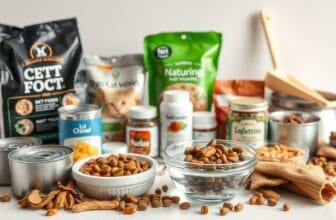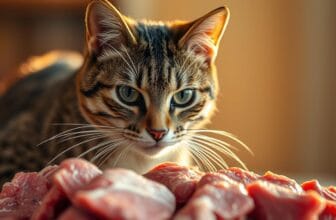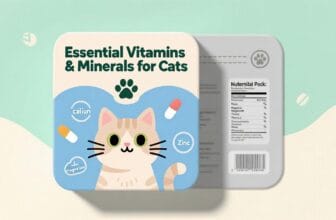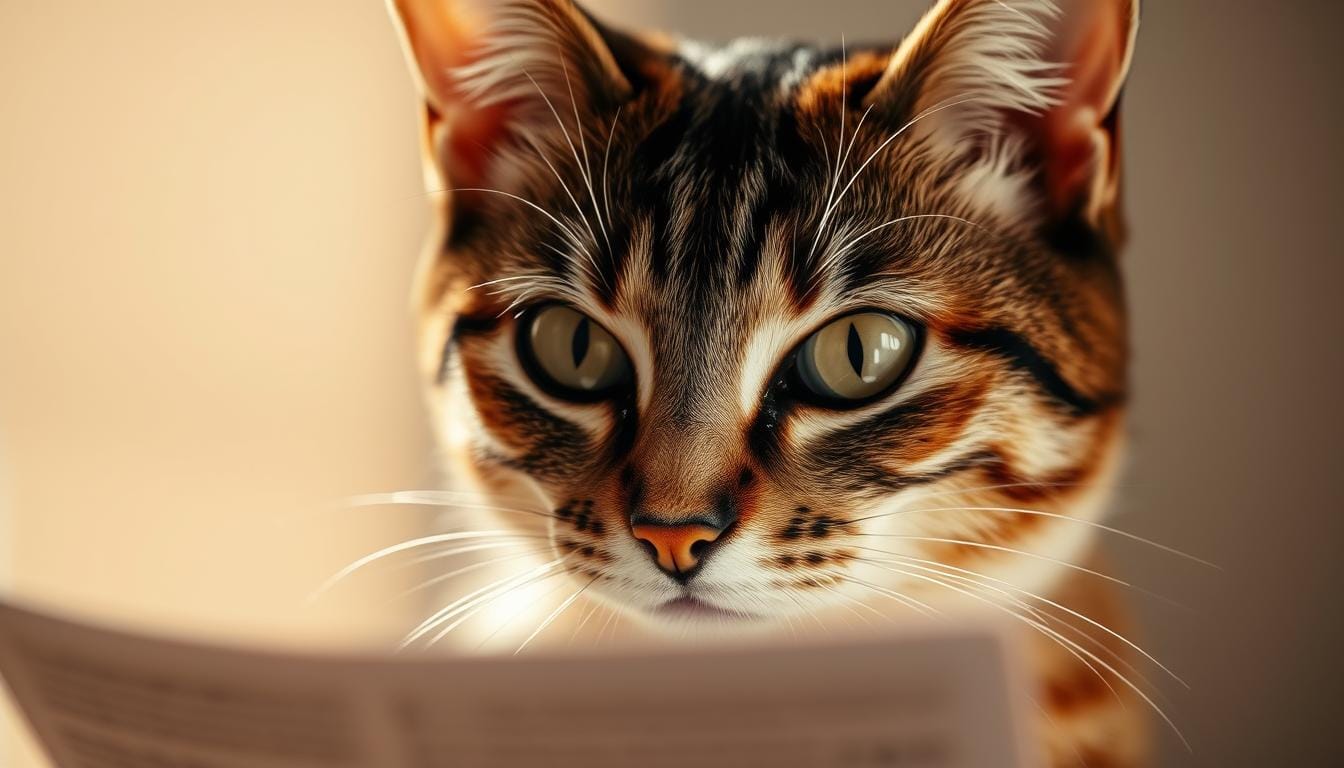
Table of Contents
Are you accidentally starving or overfeeding your cat without realizing it? It’s important to know how much to feed your cat to keep them healthy. This guide will help you understand your cat’s nutritional needs.
Feeding your cat right is more than just filling a bowl. It’s about finding the right balance for their diet. This balance depends on their age, weight, how active they are, and their health.
This guide will teach you everything about feeding your cat. You’ll learn how to measure the right amount of food and understand their metabolic needs. You’ll get expert tips to make sure your cat gets the best nutrition at every stage of their life.
Whether your cat is a playful kitten, an active adult, or a senior, knowing the right amount to feed is crucial. It helps keep them healthy and prevents obesity-related problems.
Get ready to become an expert in cat nutrition. Learn how to improve your cat’s diet with science-backed strategies.
Understanding Your Cat’s Nutritional Needs
Every cat has unique needs that change as they grow. Good nutrition is key for their health and happiness. It’s more than just filling a bowl.
Cats need animal proteins to stay healthy. Their diet must meet specific needs based on several factors.
Basic Nutritional Requirements
Your cat’s diet should include important parts for health:
- High-quality protein (primary energy source)
- Animal-based amino acids
- Fatty acids
- Vitamins and minerals
- Water
Impact of Life Stage on Feeding
Diet changes with age. Kittens, adult cats, and seniors need different foods.
| Life Stage | Key Nutritional Focus |
|---|---|
| Kittens | High protein, growth support |
| Adult Cats | Balanced maintenance diet |
| Senior Cats | Lower calories, joint support |
Caloric Needs Based on Activity Level
Calories vary by cat activity level. An indoor cat needs less than an active outdoor cat. Watch their weight to keep them healthy.
Factors That Influence Cat Feeding Portions
Knowing what affects your cat’s food intake is key to their health and weight. Several factors decide how much your cat should eat each day.
Important factors include:
- Age and Life Stage: Kittens, adults, and senior cats have different needs
- Body Weight and Size: Larger cats need more calories than smaller ones
- Activity Level: Indoor cats burn fewer calories than active ones
- Reproductive Status: Spayed or neutered cats have slower metabolisms
Health conditions can also change how much food your cat needs. Cats with diabetes, thyroid issues, or kidney disease might need special diets and careful portion control.
Getting advice from a vet helps make a feeding plan that fits your cat’s needs.
Things like indoor temperature, stress, and seasonal changes can also affect your cat’s calorie needs. Watching your cat’s weight and adjusting their food helps keep them healthy.
How Much to Feed a Cat: Daily Calorie Guidelines
Knowing how many calories your cat needs is key to their health and weight. Each cat is different, based on their age, weight, and how active they are.
Vets say cats need 25 to 35 calories per pound of body weight each day. This helps make sure they get the right food without getting too fat.
Calculating Calories per Pound
To figure out your cat’s calorie needs, think about a few important things:
- Current body weight
- Age and life stage
- Activity level
- Spayed or neutered status
Converting Calories to Portion Sizes
Turning calorie needs into the right amount of food for your cat can be tricky. Here’s a simple guide to help you get it right:
| Cat Weight | Daily Calorie Needs | Approximate Portion Size |
|---|---|---|
| 5 lbs | 125-175 calories | 1/4 to 1/3 cup dry food |
| 10 lbs | 250-350 calories | 1/2 to 2/3 cup dry food |
| 15 lbs | 375-525 calories | 3/4 to 1 cup dry food |
Adjusting Portions for Weight Management
Your cat’s weight can change, so watch it and adjust their food as needed. Consult with your veterinarian to make a diet plan that fits your cat’s health goals.
Every cat is different in how they process food. Regular vet visits and weight checks will help you adjust their diet for the best health.
Feeding Guidelines Based on Cat’s Weight
Knowing the right amount of food for your cat is key to keeping them healthy and preventing obesity. Your cat’s weight is a big factor in how much food they need each day.
Cats have special dietary needs that change with their weight and body shape. A detailed cat weight feeding chart helps you give your cat the right amount of nutrients.
- Cats under 5 pounds need smaller, more frequent meals
- Medium-weight cats need balanced portion control
- Overweight cats need carefully measured food quantities
Here’s a detailed feeding guide based on your cat’s weight:
| Cat Weight Range | Daily Calories | Recommended Portions |
|---|---|---|
| 4-6 lbs | 150-180 calories | 1/4 to 1/3 cup per day |
| 7-9 lbs | 180-220 calories | 1/3 to 1/2 cup per day |
| 10-12 lbs | 220-270 calories | 1/2 to 2/3 cup per day |
| 13-15 lbs | 270-300 calories | 2/3 to 3/4 cup per day |
Note: These guidelines are general recommendations. Always consult with your veterinarian for personalized feeding advice.
Your cat’s activity level, age, and health can affect their nutritional needs. Keep an eye on your cat’s weight and adjust their food portions to keep them healthy.
Differences in Feeding Spayed/Neutered vs. Intact Cats
After spaying or neutering, your cat’s diet needs a big change. These surgeries affect their metabolism. So, it’s crucial to watch their diet to avoid weight gain and keep them healthy.
Metabolic Changes After Surgery
Spayed or neutered cats see big changes in their metabolism. Hormonal shifts slow down their metabolism. This means you need to plan their meals carefully. Their energy needs can drop by up to 30% after surgery.
- Reduced hormone production decreases muscle mass
- Metabolism slows down naturally
- Cats become less active after surgery
Portion Adjustments for Fixed Cats
To stop obesity, you’ll need to change your cat’s diet after surgery. Neutered cats need about 20-25% fewer calories than intact ones. This helps keep them at a healthy weight and avoids health problems.
| Cat Status | Daily Calorie Needs |
|---|---|
| Intact Cat | 40 calories per kg |
| Spayed/Neutered Cat | 30-35 calories per kg |
Pro tip: Talk to your vet to make a feeding plan that fits your cat’s needs and activity level.
Wet vs. Dry Food Portion Recommendations
Knowing the right amount of wet and dry cat food is key to your cat’s health. The moisture and nutrients in each type change how much you should feed. This is important for your cat’s well-being.
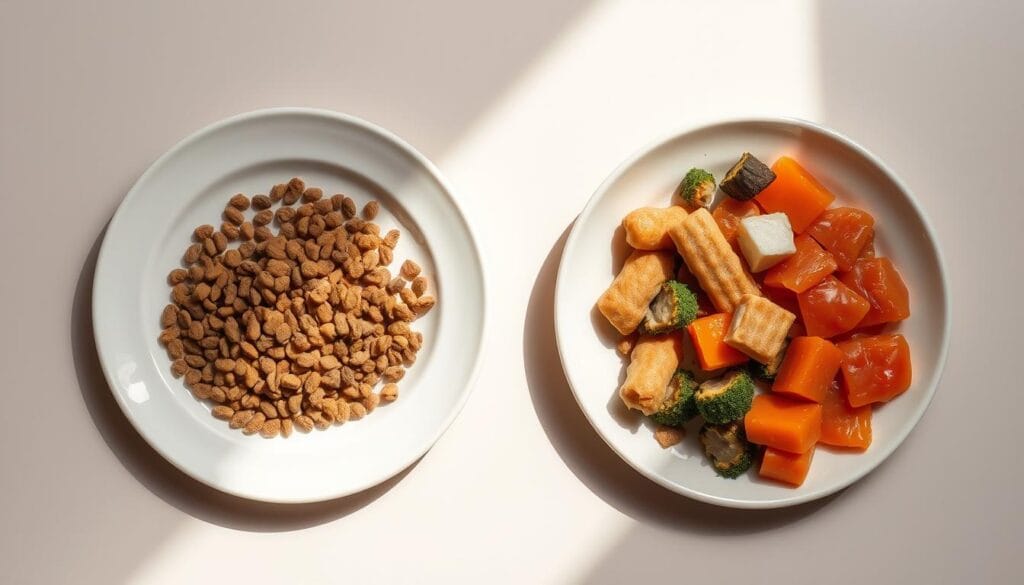
Wet and dry cat foods are different. Wet food has about 70% water, while dry food has about 10%. This difference affects how much you should feed your cat.
- Wet food is more nutrient-dense and requires smaller portions
- Dry food has higher calorie concentration per volume
- Portion sizes vary based on food type and cat’s individual needs
Wet cat food portions are usually smaller than dry food. A common rule is:
| Food Type | Average Portion Size | Calorie Density |
|---|---|---|
| Wet Cat Food | 2-3 oz per meal | 25-30 calories per ounce |
| Dry Cat Food | 1/4 to 1/2 cup per meal | 300-350 calories per cup |
Pro tip: Always check with your vet for the right dry cat food amount. This depends on your cat’s age, weight, and how active they are.
Remember, mixing wet and dry food can be good. Adjust the amounts to keep your cat at the right weight and nutrition level.
Creating an Effective Feeding Schedule
Creating a consistent cat feeding schedule is key for your cat’s health. Cats love routine. A structured feeding schedule helps keep their metabolism in check, prevents overeating, and keeps them at a healthy weight.
When planning your cat’s feeding routine, consider these key strategies:
- Stick to a consistent daily schedule
- Divide daily food portions into multiple smaller meals
- Align feeding times with your own daily routine
Morning vs. Evening Feeding
Cats usually prefer two main meals – one in the morning and another in the evening. This pattern matches their natural hunting habits and reduces hunger anxiety. Ideally, space these meals about 12 hours apart to keep their energy steady all day.
Multiple Meals Throughout the Day
Vets say adult cats should eat at least two meals a day. Some even suggest three to four smaller portions. This feeding schedule is great for:
- Cats prone to digestive issues
- Senior cats with slower metabolisms
- Cats managing weight concerns
Keep in mind, every cat is different. Talk to your vet to create a meal plan that fits your cat’s age, health, and lifestyle.
Special Feeding Considerations for Senior Cats
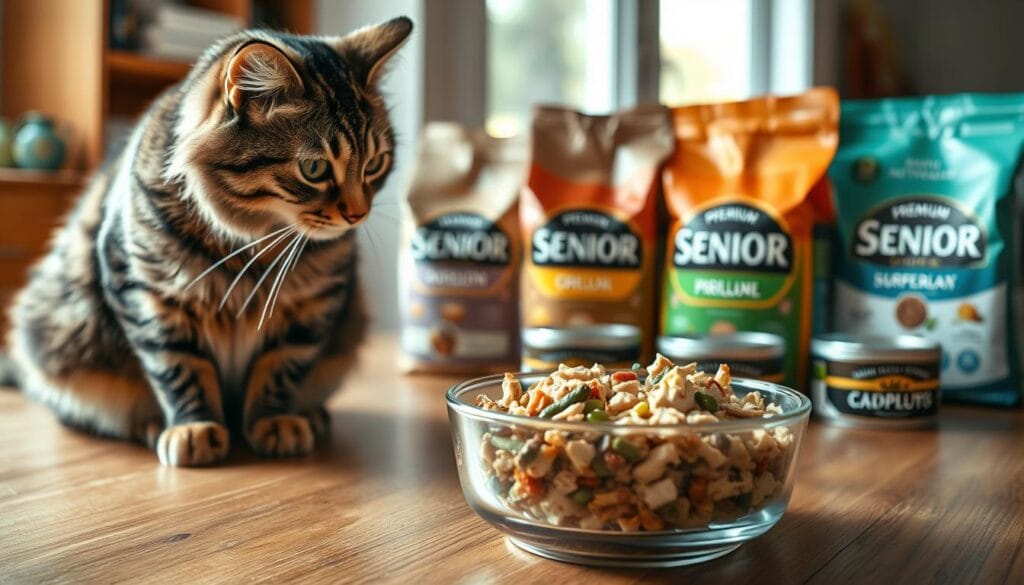
As your cat gets older, their diet becomes very important. Cats over 7 years old need different food because their bodies change. Knowing these changes helps you take better care of your aging pet.
Senior cat nutrition needs careful attention to several key factors:
- Reduced calorie requirements due to slower metabolism
- Increased need for easily digestible protein
- Lower activity levels affecting nutritional demands
- Potential health conditions requiring specialized diets
Feeding older cats is about more than just how much you feed them. Your senior cat’s diet should focus on nutrient-dense foods that support aging bodily functions. Look for specialized senior cat food formulas that address:
- Joint health support
- Kidney function maintenance
- Digestive system support
- Muscle mass preservation
When you start feeding strategies for older cats, talk to your vet. They can give you advice based on your cat’s health. This ensures you’re meeting their unique nutritional needs during this important life stage.
Signs of Overfeeding and Underfeeding
It’s important to keep your cat’s diet balanced for their health. Knowing the signs of overfeeding and underfeeding can help avoid health problems. This ensures your cat stays healthy and happy.
Many cats are overweight, with most vets saying they are 20% or more over their ideal weight. Spotting these signs early can greatly improve your cat’s health.
Weight Management Red Flags
Watching for cat overfeeding symptoms means paying attention to how your pet looks:
- Difficulty feeling ribs under fat layers
- Visible fat deposits around the abdomen
- Lack of visible waistline
- Reduced mobility and decreased activity levels
Behavioral Changes to Watch For
Signs of underfeeding in cats show up in their behavior and body:
| Overfeeding Symptoms | Underfeeding Signs |
|---|---|
| Constant lethargy | Excessive hunger |
| Rapid weight gain | Visible bone structure |
| Reduced grooming ability | Dull coat |
| Difficulty jumping | Weakness and low energy |
Pro tip: Regular vet visits are key to monitoring your cat’s weight and diet. Your vet can offer advice on the right amount to feed and what foods are best.
Measuring and Portioning Your Cat’s Food
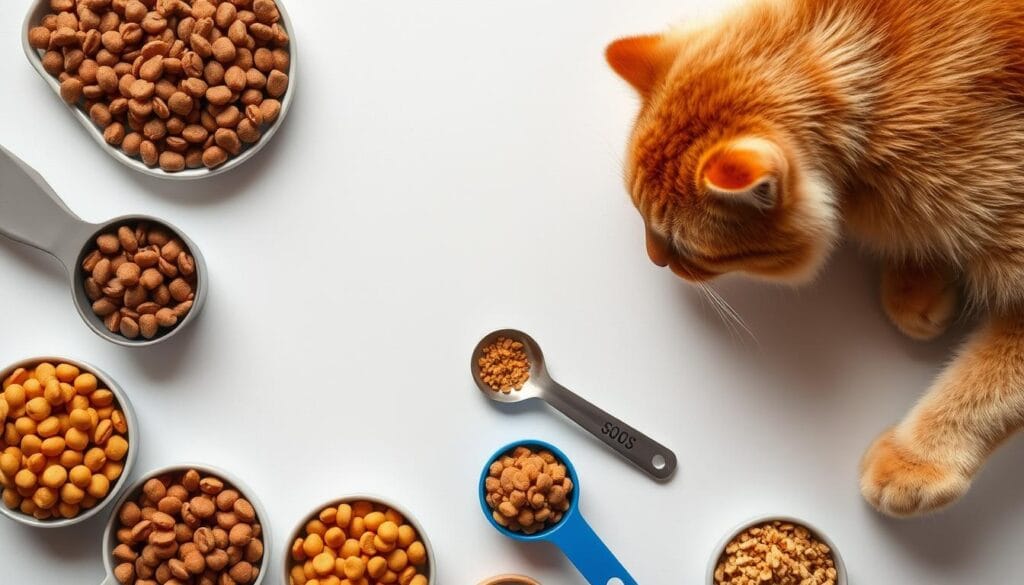
Getting the right amount of cat food is key to keeping your cat healthy and preventing obesity. Knowing how to measure and portion cat food can greatly improve your pet’s nutrition and health.
When portioning cat meals, consider a few important factors:
- Your cat’s current weight
- Age and activity level
- Type of food (wet or dry)
- Caloric content of the specific food
To measure cat food accurately, you’ll need a few tools:
- Digital kitchen scale
- Measuring cups made for pet food
- Calorie calculator for cats
Reading pet food labels is crucial for correct portioning. Look for these important nutritional details:
| Label Information | What to Look For |
|---|---|
| Calories per cup | Typically ranges from 300-500 calories |
| Recommended serving size | Based on cat’s weight and age |
| Protein percentage | Minimum 26% for adult cats |
Pro tip: Always measure food precisely and avoid free-feeding to prevent potential weight issues.
Remember, every cat is different. Talk to your vet to create a feeding plan that meets your cat’s unique needs. This will help keep your cat healthy and well-nourished.
Transitioning Between Different Food Types
Changing cat food needs patience and careful planning. A gradual transition is key to avoid digestive issues and keep your cat comfortable.
Here are the steps to start the transition:
- Mix a small amount of new food with the current food
- Gradually increase the new food over 7-10 days
- Keep an eye on your cat’s reaction and appetite
- Watch for any signs of digestive upset or reluctance
Pro tip: Cats are creatures of habit, and sudden dietary changes can cause stress and gastrointestinal problems.
“Patience is key when introducing new foods to your feline friend.” – Veterinary Nutrition Experts
The best transition follows this percentage breakdown:
- Days 1-3: 25% new food, 75% current food
- Days 4-6: 50% new food, 50% current food
- Days 7-9: 75% new food, 25% current food
- Day 10: 100% new food
If your cat resists the change, try these tips:
- Warm the new food slightly to enhance aroma
- Mix in a small amount of favorite treat
- Reduce portion sizes if your cat seems overwhelmed
Remember, every cat is different. Some may need a slower or faster transition. Always talk to your vet if you face persistent feeding challenges during the transition.
Managing Treats Within Daily Caloric Needs
Showing love to your cat with treats is wonderful. But, it’s important to keep an eye on cat treat calories. Experts say treats should not make up more than 10% of your cat’s daily calories.
It’s key to know how to add treats without upsetting your cat’s diet balance. Here are some tips for managing treats:
- Calculate your cat’s daily calorie needs
- Choose treats that are full of nutrients
- Use treats as special rewards
- Keep an eye on your cat’s weight
When picking treats, go for quality over quantity. Low-calorie, protein-rich options are great for keeping your cat’s mind sharp without harming their diet.
| Treat Type | Calories per Treat | Nutritional Value |
|---|---|---|
| Freeze-dried meat | 5-10 calories | High protein, low carb |
| Commercial cat treats | 10-20 calories | Varied nutritional profile |
| Homemade treats | 5-15 calories | Controlled ingredients |
Remember, balancing your cat’s diet is about making healthy choices. Talk to your vet to create a treat plan that fits your cat’s needs.
Conclusion
Understanding your cat’s diet can seem hard, but it’s key for their health. Good cat feeding practices are more than just filling a bowl. They involve thinking about your cat’s age, weight, activity level, and health.
Creating a feeding plan that fits your cat can avoid problems like obesity and malnutrition. By watching portion sizes and choosing quality foods, you can make your cat’s life better. The feline nutrition summary we’ve looked at offers a clear guide for caring for your pet.
Your vet is the best source for advice on your cat’s diet. Every cat is different, so your vet can help tailor your feeding plan. Regular vet visits, talking openly with your vet, and watching your cat’s health closely are all important. They help make sure your cat gets the right food at every stage of their life.
Nutrition is a journey, not a one-time task. Keep learning, be open to changes, and always focus on your cat’s special dietary needs. With commitment and knowledge, you can give your cat the best nutrition.
FAQ
How many calories does my cat need daily?
Your cat’s daily calorie needs depend on several factors. These include weight, age, activity level, and if they’re spayed or neutered. On average, an adult cat needs about 20 calories per pound of body weight. But, this can change. Talking to your vet can help figure out what your cat needs exactly.
How often should I feed my cat?
Most adult cats do well with two meals a day, 12 hours apart. But, some cats might need smaller meals more often. Kittens and senior cats might need to eat more frequently. The goal is to find a routine that fits your cat’s needs and your schedule.
How do I know if I’m overfeeding my cat?
Signs of overfeeding include weight gain, like not feeling your cat’s ribs or a round belly. Less activity and feeling tired can also mean too much food. Weighing your cat regularly and checking with your vet can help keep them at the right weight.
Do spayed or neutered cats need different portion sizes?
Yes, spayed and neutered cats need fewer calories because they metabolize slower. After surgery, cut their food by 20-30% to avoid weight gain. Your vet can help create a diet plan that fits these changes.
What’s the difference between wet and dry cat food portions?
Wet food has more moisture and fewer calories than dry food. So, portion sizes differ. Always follow the feeding guidelines on the packaging and adjust based on your cat’s needs.
How do I transition my cat to a new food?
Introduce new food slowly over 7-10 days. Start with 25% new food and 75% old food. Then, gradually increase the new food while decreasing the old. This helps your cat adjust without upset stomachs.
How many treats can I give my cat?
Treats should be no more than 10% of your cat’s daily calories. For a 250-calorie cat, that’s about 25 calories. Choose healthy treats and include them in your cat’s daily diet plan.
Do senior cats have different nutritional needs?
Yes, senior cats need fewer calories but more nutrient-dense food. Their metabolism slows, and they’re less active. Special senior cat foods support their aging needs, like joint health and digestion.
How can I measure my cat’s food accurately?
Use a measuring cup or kitchen scale for precise portions. Read food labels for calorie info and serving sizes. Digital scales are best for wet or dry food measurements.
What factors affect how much my cat should eat?
Several factors influence your cat’s needs, like breed size, metabolism, health, activity, age, and spaying/neutering. Each cat is different, so a personalized feeding plan is key.



